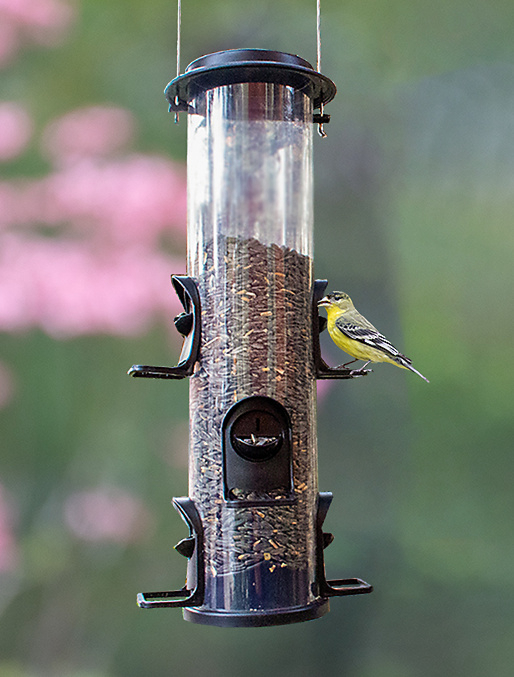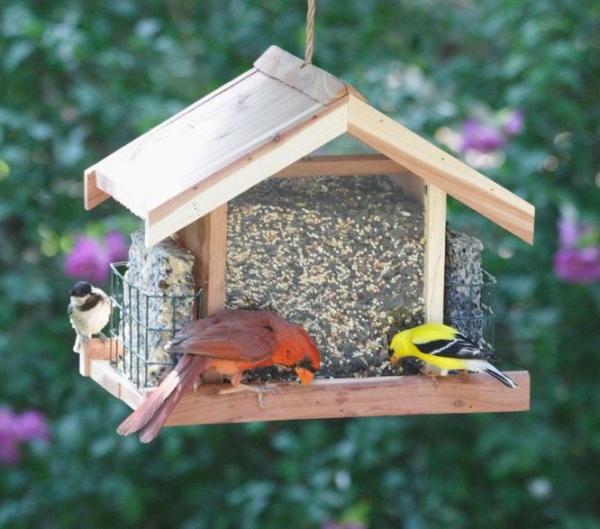
Tube feeders are best for offering nyjer thistle seeds for smaller birds, such as the Perky-Pet Black 2-in-1 XL Tube Feeder with 6 feeding ports.

Some feeders offer options for larger seeds plus suet cakes, like the Perky-Pet Deluxe Chalet Cedar Feeder.
|
As fall colors progress southward with the cooling temperatures of October, birds that will become winter feeder visitors are working their way south too. Re-imagine your feeding station with many goldfinches, siskins, nuthatches, woodpeckers, grosbeaks, redpolls, native sparrows - even crossbills on hand. Plus local birds like cardinals, chickadees, and jays are scouting where reliable food sources exist as they transition from summer insects and berries to fall seeds and suet. It’s time to transition to offer “fall and winter foods” – if you haven’t already made that move.
With migratory species of hummingbirds and orioles well on their way to wintering areas in Latin America, the rule of thumb is to keep your nectar and jelly feeders up for a couple weeks after you see the last hummingbird or oriole. Some birders like to keep their nectar feeder up a little longer though, just in case a wayward hummingbird – often a Rufous Hummingbird – might appear. But most local and migrating feeder birds are looking for other options.
Suet – We’ve had our suet feeder up for a month now, as soon as we observed the first woodpeckers and nuthatches arrive. Feeding suet isn’t what it used to be, with all the different mixes and flavors available. We prefer to use hot pepper no-melt suet – foremost because birds like it, but it repels squirrels that disdain the hot pepper taste.
Also, the no-melt quality of the suet works especially well during warmer weather, but it has other qualities that make it a preferred product. The dry non-greasy quality of no-melt suets has been a plus for us after we noticed some woodpeckers getting a grease on their plumage when we used traditional high-fat suet. The no-melt recipes eliminate the possibility of that, and they don’t attract flies and other insects during warmer months.
In addition to suet, a similar product provides an opportunity for you to treat birds – it’s Bark Butter, a spreadable suet-like product that 152 species of birds are known to have used. You can literally spread Bark Butter on the bark of a tree, or offer it in a specialized feeder – and it’s available in a hot pepper mix to repel squirrels too. There are also pellet-like Bark Butter Bits that are favored by some birders who offer it in feeders. Any way you offer it, Bark Butter is a Wild Birds Unlimited product, so you can get a tub full at a WBU store, or at their online website at https://www.wbu.com/products/bark-butter/bark-butter/ WBU and other local birding stores are your best bet as you prepare for fall bird feeding options.
Seeds – Perhaps you’ve been lucky enough to have goldfinches in your neighborhood and have attracted them to your tube feeder stocked with tiny nyjer thistle seeds, and this staple for small seed-eating birds should be an important element of any fall and winter feeding station. Certainly, chickadees, siskins, redpolls, and other smaller seed-eating birds will utilize thistle seeds in a tube feeder too.
The real meat of a fall and winter feeding station is a hearty mix of seeds for larger birds that includes a strong element sunflower seeds, some nut parts, and perhaps some millet. We have become pretty quality-oriented in our seed mix choices, and even prefer to feed shelled seed mixes. The package price may appear a little more expensive, but when you consider you’re not paying for shells, and that you can eliminate the mess of sunflower seed shells littering the area surrounding your feeding station we feel it’s a win-win option.
Squirrels or No Squirrels – That is the question. If you like feeding squirrels and chipmunks, more power to you; they are an interesting and lively part of our fauna. Some birders give them the run of their feeding station, and some prefer to make a separate squirrel-feeding site with foods squirrels prefer, including corn and peanuts and regular suet, in another part of their yard to try to separate the mammals from the birds.
Many birders keep squirrels at bay by using specialized anti-squirrel bird feeders, which is usually the best option if you are so inclined. Some people use baffles to thwart squirrels, and a others have warmed up to using hot pepper treated seed mixes and suet, as described above, which essentially repels squirrels from having any interest in your feeding station. Even just using the treated seeds periodically in a feeder might help steer squirrels away from your bird feeders, but that would take a bit of experimenting to see what works best for your interests.
Whatever seeds you provide, be sure to keep your feeders well-stocked and avoid “empty” periods. It’s always best if birds recognize your feeding station as a reliable source of food, and that’s obviously part of being a good feeding station landlord.
Water – As always, providing fresh water is the easiest and cheapest way of attracting a variety of birds, and looking into the future – November and beyond – it’s time to consider adding a heated bird bath to your feeding station. There are a lot of benefits for birds to be able to access water throughout the winter, especially when freezing temperatures limit other water options.
Sunbelt Feeding Stations – Of course, many birders who live or winter along the southern tier of states can enjoy continuing to see local hummingbirds along with wintering warblers, thrushes, finches, and a wealth of other birds using their feeding station and water feature, with new species arriving as fall migration progresses. For you, it’s business as usual, although you may be beefing up your seed feeders too, and adding a no-melt suet option.
Regardless of where you live, October provides a time to plan, prepare, and improve the varied elements of your feeding station for birds that arrive tomorrow, next month, and beyond. It’s an exciting time for all of us, and keep alert for new birds in your yard, including first of fall arrivals as migration continues day by day.
Share your backyard birding experiences and photos at editorstbw2@gmail.com